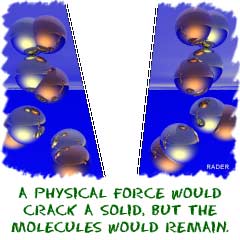1:45 AM Compound Basics | |
Compound BasicsCompounds are groups of two or more elements that are bonded together. You have also seen us use the word molecule. Molecule is the general term used to describe atoms connected by chemical bonds. Every combination of atoms is a molecule. Compounds happen with atoms from different elements. So, all compounds are molecules, because they have bonds between the atoms, like in water (H2O). However, not all molecules are compounds because sometimes the atoms are of the same element. Hydrogen gas (H2) is a good example of a molecule that is not a compound. There are two main types of chemical bond that hold atoms together: covalent and electrovalent/ionic bonds. Covalent compounds happen when the atoms share the electrons, and ionic compounds happen when electrons are donated from one atom to another. We talked about compounds and molecules in the Matter section. When we discuss phase changes in matter, physical forces create the changes. When we talk about compounds, bonds are built and broken down by chemical forces.
Physical forces alone (unless you're inside of the Sun or something
extreme) cannot break down compounds. Chemical forces are forces
generated by other compounds or molecules that act on substances. You
can apply the physical force of heat to melt an ice cube and there is no
change to the water molecules. You can also pour a liquid acid on a
solid and watch the solid melt, but that is a chemical change because
molecular bonds are being created and destroyed.
We talked about compounds and molecules in the Matter section. When we discuss phase changes in matter, physical forces create the changes. When we talk about compounds, bonds are built and broken down by chemical forces.
Physical forces alone (unless you're inside of the Sun or something
extreme) cannot break down compounds. Chemical forces are forces
generated by other compounds or molecules that act on substances. You
can apply the physical force of heat to melt an ice cube and there is no
change to the water molecules. You can also pour a liquid acid on a
solid and watch the solid melt, but that is a chemical change because
molecular bonds are being created and destroyed.
There are millions of different compounds around you. Probably everything you can see is one type of compound or another. When elements join and become compounds, they lose many of their individual traits. Sodium (Na) alone is very reactive. But when sodium and chlorine (Cl) combine, they form a non-reactive substance called sodium chloride (salt, NaCl). The compound has few or none of the traits of the original elements. The new compound is not as reactive. It has a new life of its own. Different Bonds AboundMost compounds are made up of combinations of bonds. If you look at sodium chloride, it is held together by one ionic/electrovalent bond. What about magnesium chloride (MgCl2)? It contains one magnesium (Mg) and two chlorine atoms. There are two ionic bonds. There's a compound called methane (CH4) that is made up of one carbon (C) and four hydrogen (H) atoms. There are four bonds and they are all covalent. Those examples are very simple compounds, but most compounds are combinations of ionic and covalent bonds.Let's look at sodium hydroxide (Na-OH)...  You can see the sodium (Na) part on the left and the hydroxide (-OH) part on the right. The bond that binds the hydrogen (H) to the oxygen (O) is covalent. The sodium is bonded to the hydroxide part of the compound with an ionic/electrovalent bond. This is a very good example of how there can be different types of bonds within one compound. | |
|
| |
| Total comments: 0 | |